
Burlington School District supports allowing young children to choose their gender identity and pronouns; promotes segregated “affinity spaces” for students and staff
Incidents
The Burlington School District has a “Diversity and Equity” page on its website that promotes using the preferred “pronouns” of students. The school district explains that “it is best teaching practice to create an inclusive space by asking students and staff to share their pronouns during introductions, on name tags, on email signature lines, etc.” The school district continues to explain that “including pronouns is a simple way to show respect towards people’s gender identity” and that “asking for pronouns helps us to avoid assuming a person’s gender identity based on their appearance.”
The school district states that “students should be addressed by school staff by the name and pronoun corresponding to their gender identity.” If students previously used their real names at school, teachers must still “use the student’s chosen/preferred name and gender identity.” The school district then provides a document titled “Pronouns: A Resource” from the organization GLSEN.
GLSEN is known for promoting LGBTQ issues to young children. GLSEN states on its website that “while many LGBTQ+-inclusive school supports begin in middle or high school, it is critical for elementary schools to establish a foundation of respect and understanding for all people.” The organization has also appeared to show support for children taking “hormone replacement therapy” to transition to another gender:
Upon birth, we are typically categorized into one of two genders (boy or girl) depending on how our genitals are read. Throughout our lives, however, our many bodily characteristics work together to create a unique path of development, causing some of us to grow really tall, and others to remain short, or some of us to grow hair under our armpits and legs, while others remain bare. While this development often happens on its own during puberty, this change can also be administered through medicine, such as hormone replacement therapy. Since our society often conflates our bodies (or genitalia) with our gender identity, it is critical that we allow space for people to self-identify.
The GLSEN document promoted by the school district explains that people are sharing their pronouns “to make spaces more inclusive of transgender, gender nonconforming, and gender non-binary people.” GLSEN continues to explain in the document that “including pronouns is a first step toward respecting people’s gender identity, working against cisnormativity, and creating a more welcoming space for people of all genders.”



In a statement on the “Diversity and Equity” page, the school district states that “equity in education means creating a culture that actively works to ensure access by acknowledging and addressing bias and discrimination that negatively affect our students, their families, and our staff and working to dismantle systems of oppression and White supremacy culture in schools.” The school district then lists objectives that need to be accomplished to achieve “educational equity”:
- Interrupting and dismantling inequitable systems, practices, policies, and procedures; continually examining and re-examining biases
- Replacing inequitable systems, practices, policies and procedures with just and equitable systems, practices, policies and procedures
- Creating inclusive, anti-racist, culturally relevant curriculum and school environments for adults and children
- Redistributing District resources based on academic, social and economic data to better serve our most marginalized students and families
- Collaborating and including students, families and community members to build a truly inclusive community where all voices are valued
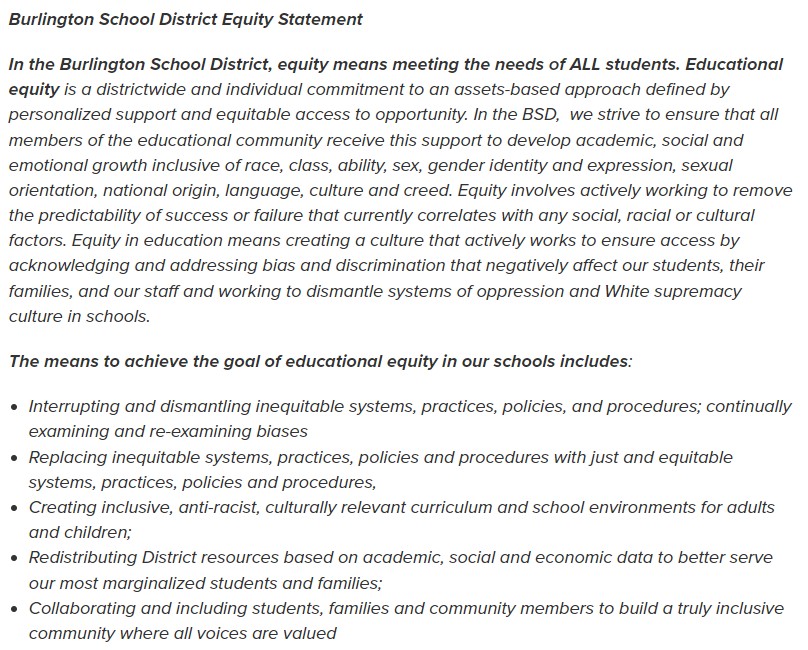
The school district promotes an “Equity Community Workshop Series” on its website. Discussions include “Let’s Talk about Gender Identity and Expression,” “Let’s Talk about Whiteness,” and “Let’s Talk about Anti-Racism.” The description for “Let’s Talk about Anti-Racism” specifically discusses “examining systemic racism” in “K-12 schooling.”
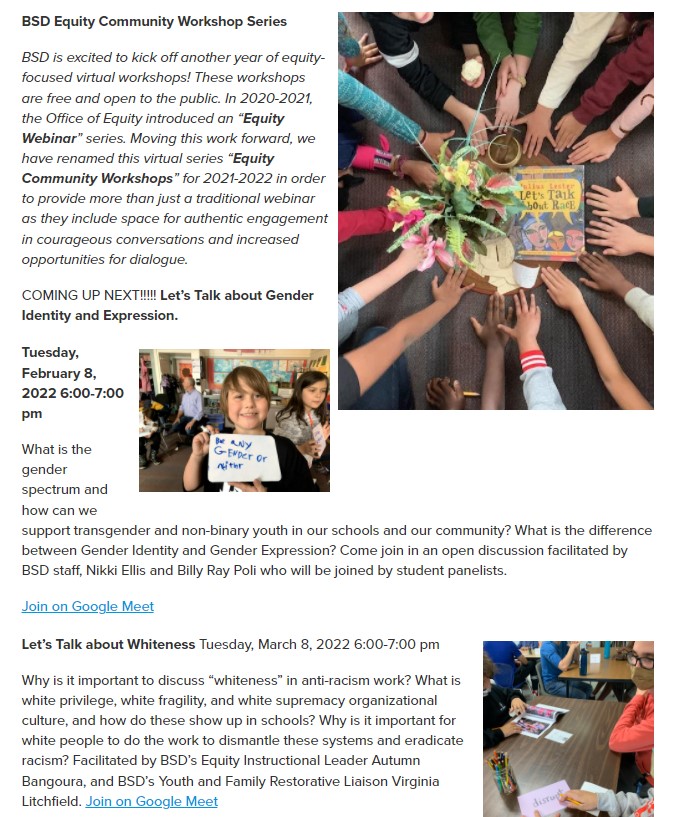
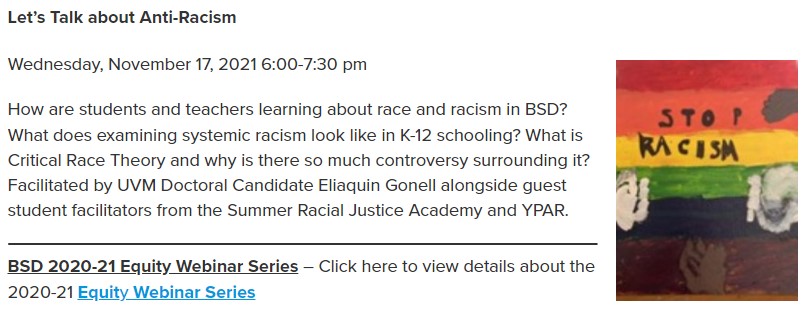
The school district also trains teachers in “equity conversations.” Topics for these conversations include “White Privilege,” “Queer and Trans 101,” “Cultural Proficiency,” “Looking at Data through an Equity Lens,” “Characteristics of White Supremacy Culture,” and “The Anti-Racist Educator.” The topic “Queer and Trans 101” includes a link to the website for the organization “Outright Vermont” that specifically targets young children. Outright Vermont promotes a “social group” called “Gender Creative Kids” for children who are younger than 13 years old. The organization explains that Gender Creative Kids is for children “who fall outside traditional ideas of gender, but welcome other definitions.”
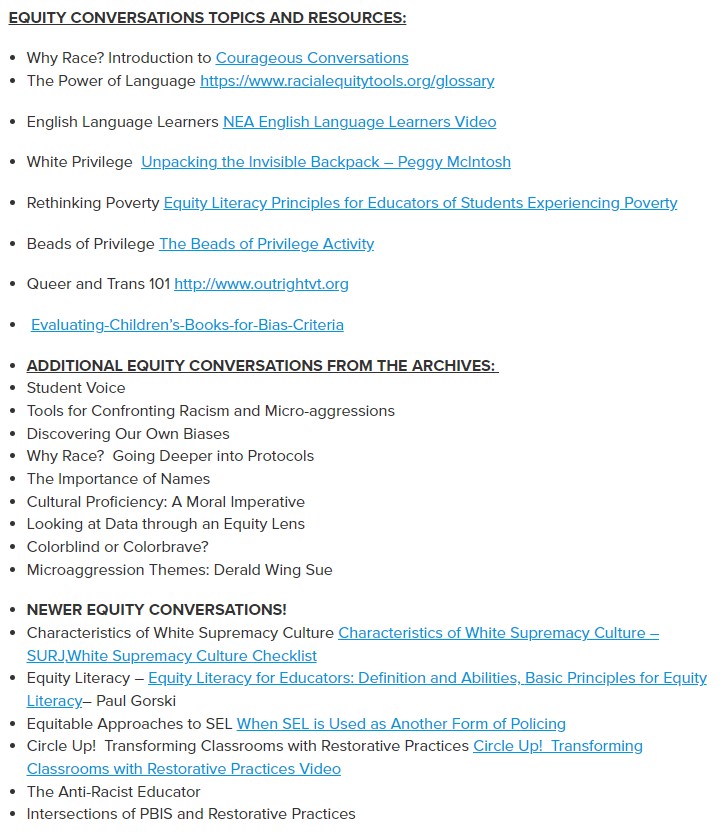
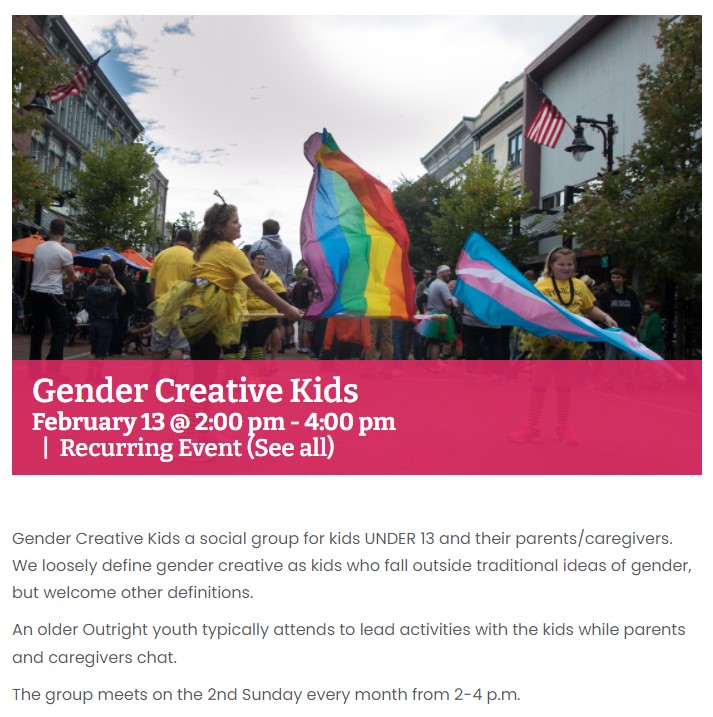
In the 2020 annual report, the school district listed its achievements “in the areas of Diversity, Equity, and Inclusion” in the 2019-2020 school year. One achievement was listed as “raised the Black Lives Matter Flag at Edmunds Middle and Elementary School Complex.” Another achievement was that the school district “piloted a Social Justice Curriculum at K-6 levels.” The school district also has an “Equity and Inclusion Data Report 2019-2020.” In this report, the superintendent stated that it is the school district’s “moral imperative to disrupt these systems of structural racism, ableism, and discrimination based on sexual orientation and gender identity.” In an effort to hire more diverse teachers, the report stated that the school district will “broaden areas of race and gender identity in application process to be more inclusive.”
The school district’s website has a page for “Diversity and Equity Resources.” One resource links to “Learning for Justice.” The organization Learning for Justice is known for offering resources to help educators teach their students about “social justice” and equity. One resource that Learning for Justice specifically offers is called the “Social Justice Standards.” The document for these standards includes goals to achieve for students. One goal is that “students will develop language and historical and cultural knowledge that affirm and accurately describe their membership in multiple identity groups.” Another goal appears to outright state that the purpose of the “Social Justice Standards” is to turn students into political activists: “Students will make principled decisions about when and how to take a stand against bias and injustice in their everyday lives and will do so despite negative peer or group pressure.”

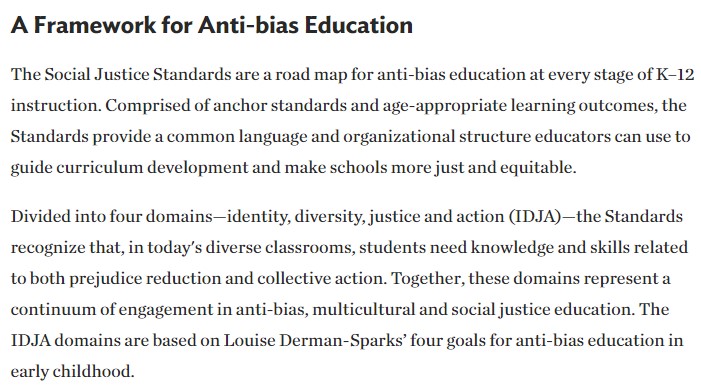
The equity resources also include additional resources for “culturally responsive teaching.” The phrase “culturally responsive teaching” is often used to describe a method of teaching that includes the race and ethnicity of students as part of the lessons taught in classrooms. More resources are focused on “examining whiteness.” One resource in this category is labeled “Racial Equity Tools: White Supremacy and White Privilege.” This resource includes links to articles and reports titled “The Problem Is White Supremacy,” “The Anatomy of White Guilt,” “White Fragility,” “Understanding Whiteness,” “White Women Doing White Supremacy in Nonprofit Culture,” and “White Women: Our Role in Racial (In)Justice.” Another resource the school district promotes is called the “Teaching While White Podcast.”
The school district also provides students and teachers with Black Lives Matter resources, including a resource called “The 1619 Project Curriculum.” This resource outright states that the purpose of the 1619 Project is “to reframe U.S. history by marking the year when the first enslaved Africans arrived on Virginia soil as our nation’s foundational date.” The resource continues to state that “here you will find reading guides, activities, and other resources to bring The 1619 Project into your classroom.”
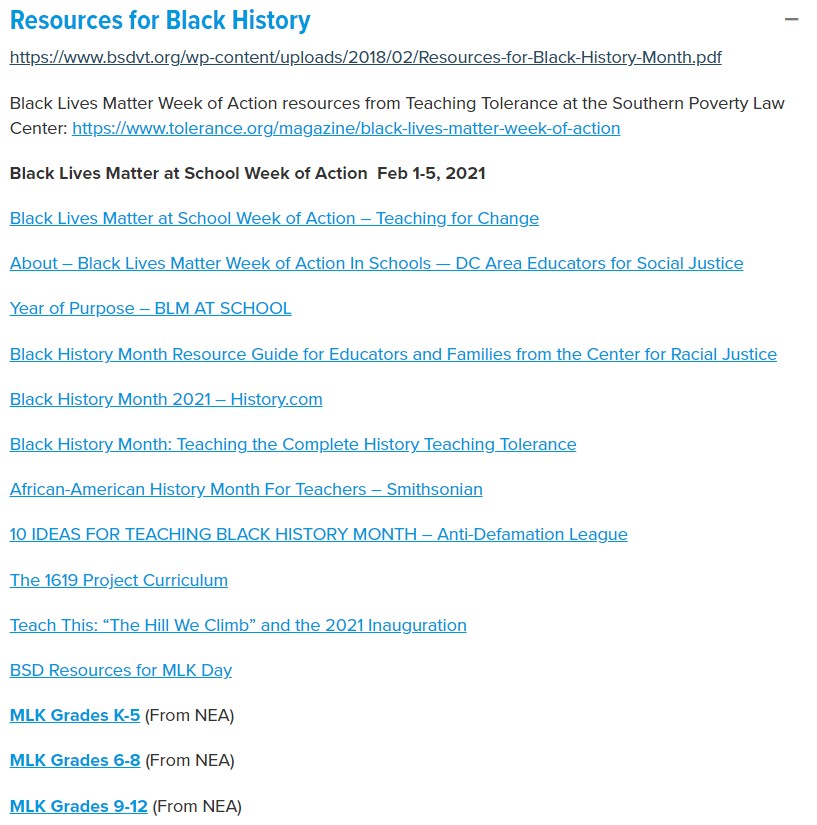

The school district offers resources to promote “LGBTQIA+ Awareness.” Resources include links to the websites of Outright Vermont and GLSEN. One resource is a Learning for Justice document titled “Best Practices for Serving LGBTQ Students.” The document promotes changing the curriculum to be more “LGBTQ” friendly: “Discover strategies for integrating LGBTQ perspectives into your curriculum and navigating challenges that may result.” The document also states that “students should have access to bathrooms, locker rooms and other gender-specific spaces that best match their gender identity.” The document also goes a step further and explains that “schools should, to the best of their ability, allow students to play on sports teams and clubs that best match their gender identity.”
The Learning for Justice document even includes a section that teaches LGBTQ activists how to push their agenda when “the community pushes back.” Learning for Justice then uses the document to label organizations that fight back as “hate groups”:
Be aware of local and national hate groups that actively target schools over LGBTQ-inclusive practices. For example, the Liberty Counsel has organized letter campaigns and even hassled individual teachers to pressure educators into resisting things like inclusive sex ed. The Alliance Defending Freedom is another group heavily organizing against practices such as allowing trans students to use facilities that match their gender identity. In some cases, both groups offer free legal counsel to sue the schools. Arm yourself with information so you can counter their misleading messages.

On December 6, 2021, the school district published an article announcing a new “LGBTQ+ Task Force.” The job of the task force is to create a plan with the following objectives:
- Identify and document what is already being accomplished in BSD schools that builds awareness and advocacy for the LGBTQ+ community.
- Ensure the safety of Burlington’s students during and outside of school hours as related to teasing, taunting, and harassment due to gender identity, gender expression, and sexual orientation.
- Create a list of recommendations that will inform the BSD Strategic Plan.
- Present recommendations and Task Force final report to the Superintendent.
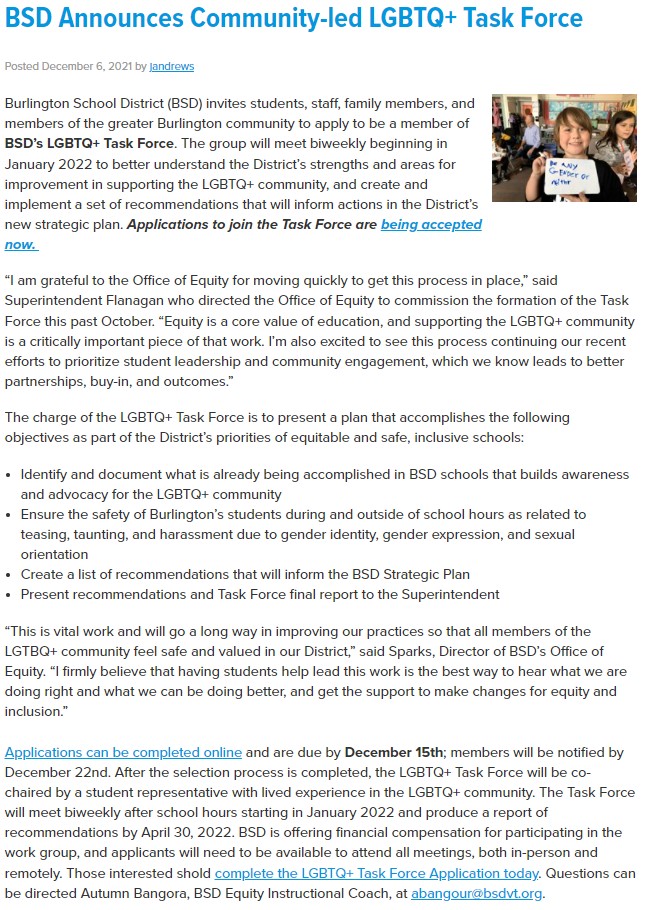
On November 18, 2020, the school district published an article announcing “BIPOC Affinity Spaces.” The school district stated that “with the current racial reckoning in the USA and the pandemic disproportionately affecting BIPOC peoples, we brainstormed ways to create healing spaces for students of color by creating BIPOC Affinity Spaces.” The school district then listed goals of these “affinity spaces”:
- Build relationships between students with shared identities.
- Allow students of color to safely express their voices, share stories and help navigate their school experiences.
- Hold friendly conversations over a meal in a “lunch bunch” format.
- Have fun and share joy.
- Provide adult role models and mentorship.
- Uplift student voices and provide platforms for group advocacy.
The school district also listed affinity spaces for the 2020-2021 school year. These affinity spaces appear to segregate students and staff based on their race:
- IAA Student of Color Affinity Space – 4th and 5th grade students of color gather in a supportive and healing space every Friday.
- SA Social Justice Club – Students interested in Social Justice activism and the relationship with Sustainability meet every Friday.
- Students of Color Alliance Virtual Affinity Space for EMS and HMS Students – Virtual meeting open to all middle school students of color that meets every Friday 5-6 pm.
- BSD Staff BIPOC Affinity Space – a space of solidarity for BSD staff of color with bimonthly meetings
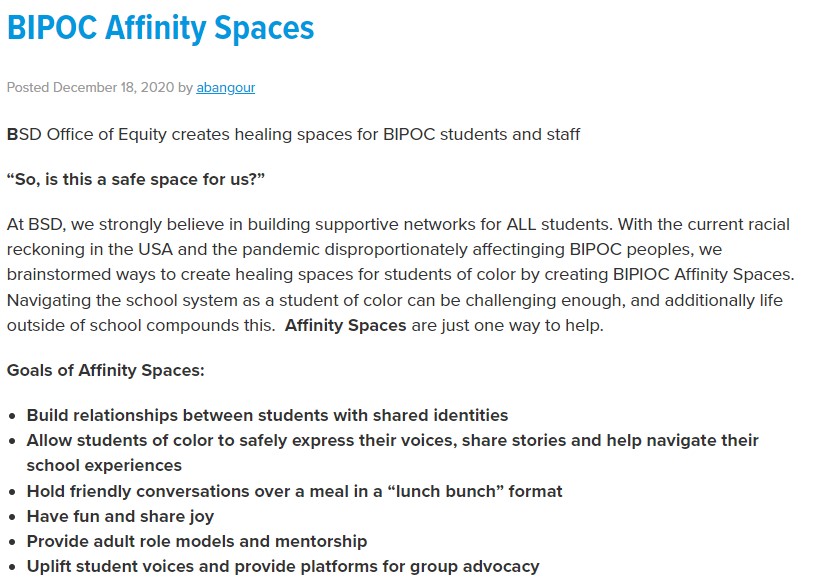

The school district’s website has a page titled “Equity Request Ticket.” The page states that “the District Office of Equity welcomes feedback so that we can work together to improve the climate.” The page then asks for people to submit “equity requests” so that “inequities or biases” can be identified. Parents, teachers, students, and community members can submit these requests.
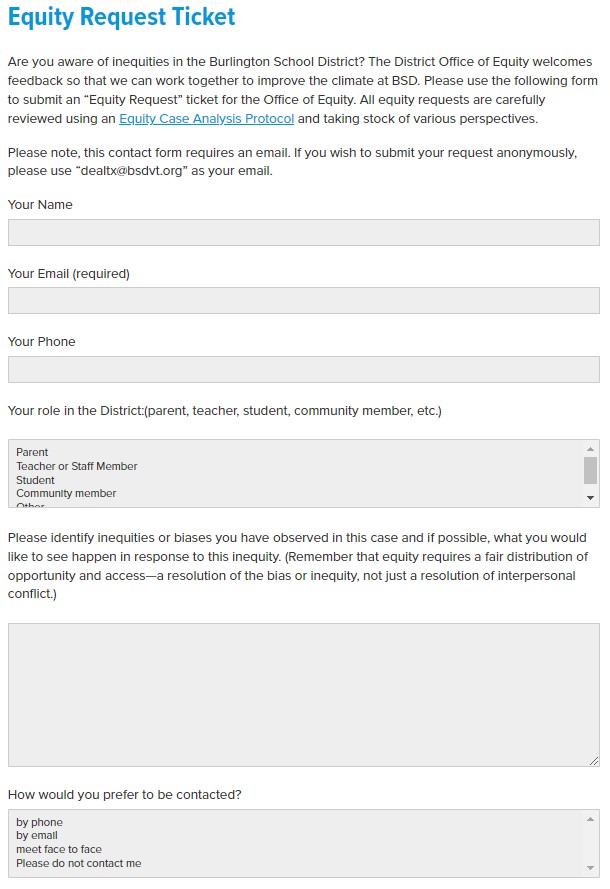
The school district has a website dedicated to Social-Emotional Learning (SEL). The school district promotes several resources from CASEL to explain the perceived importance of SEL, including a link to a page on CASEL’s website called “How Does SEL Support Educational Equity and Excellence?” CASEL is an organization that works with school districts throughout the country to use SEL in an effort to push “equity” and “social justice” in education.
On July 1, 2020, CASEL promoted “racial justice” in discussing its roadmap for reopening schools during the COVID-19 pandemic. In explaining the importance of the reopening process for schools, the organization stated that “this moment called on all members of our school communities to deepen our social and emotional competencies and create equitable learning environments where all students and adults process, heal, and thrive.” CASEL also published a video in 2020 titled “SEL As a Lever for Equity and Social Justice.”
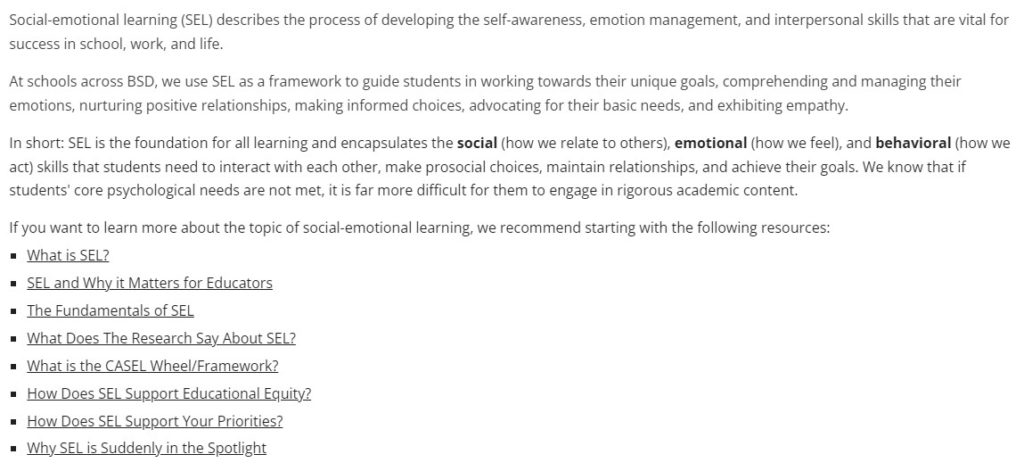
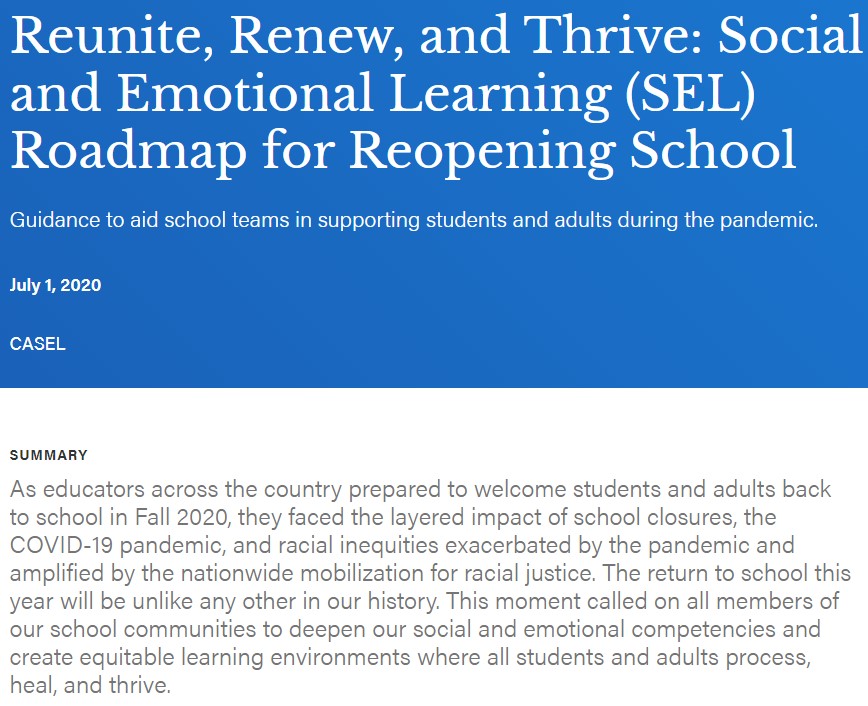
Stay Informed
